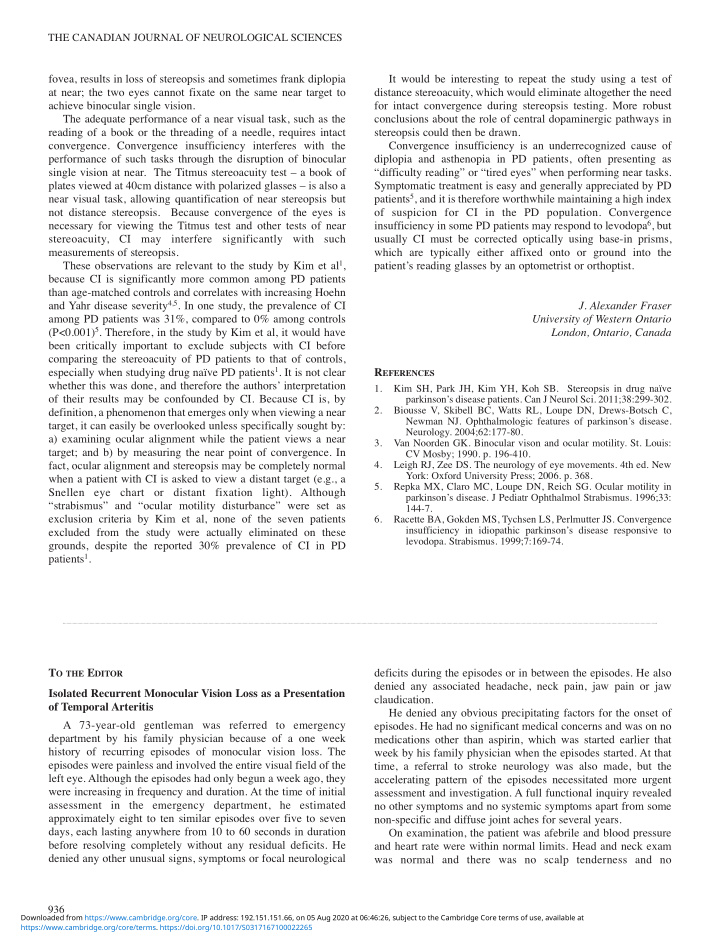



THE CANADIAN JOURNAL OF NEUROLOGICAL SCIENCES fovea, results in loss of stereopsis and sometimes frank diplopia It would be interesting to repeat the study using a test of at near; the two eyes cannot fixate on the same near target to distance stereoacuity, which would eliminate altogether the need achieve binocular single vision. for intact convergence during stereopsis testing. More robust The adequate performance of a near visual task, such as the conclusions about the role of central dopaminergic pathways in reading of a book or the threading of a needle, requires intact stereopsis could then be drawn. convergence. Convergence insufficiency interferes with the Convergence insufficiency is an underrecognized cause of performance of such tasks through the disruption of binocular diplopia and asthenopia in PD patients, often presenting as single vision at near. The Titmus stereoacuity test – a book of “difficulty reading” or “tired eyes” when performing near tasks. plates viewed at 40cm distance with polarized glasses – is also a Symptomatic treatment is easy and generally appreciated by PD patients 5 , and it is therefore worthwhile maintaining a high index near visual task, allowing quantification of near stereopsis but not distance stereopsis. Because convergence of the eyes is of suspicion for CI in the PD population. Convergence insufficiency in some PD patients may respond to levodopa 6 , but necessary for viewing the Titmus test and other tests of near stereoacuity, CI may interfere significantly with such usually CI must be corrected optically using base-in prisms, measurements of stereopsis. which are typically either affixed onto or ground into the These observations are relevant to the study by Kim et al 1 , patient’s reading glasses by an optometrist or orthoptist. because CI is significantly more common among PD patients than age-matched controls and correlates with increasing Hoehn and Yahr disease severity 4,5 . In one study, the prevalence of CI J. Alexander Fraser among PD patients was 31%, compared to 0% among controls University of Western Ontario (P<0.001) 5 . Therefore, in the study by Kim et al, it would have London, Ontario, Canada been critically important to exclude subjects with CI before comparing the stereoacuity of PD patients to that of controls, especially when studying drug naïve PD patients 1 . It is not clear R EFERENCES whether this was done, and therefore the authors’ interpretation 1. Kim SH, Park JH, Kim YH, Koh SB. Stereopsis in drug naïve of their results may be confounded by CI. Because CI is, by parkinson’s disease patients. Can J Neurol Sci. 2011;38:299-302. 2. Biousse V, Skibell BC, Watts RL, Loupe DN, Drews-Botsch C, definition, a phenomenon that emerges only when viewing a near Newman NJ. Ophthalmologic features of parkinson’s disease. target, it can easily be overlooked unless specifically sought by: Neurology. 2004;62:177-80. a) examining ocular alignment while the patient views a near 3. Van Noorden GK. Binocular vison and ocular motility. St. Louis: target; and b) by measuring the near point of convergence. In CV Mosby; 1990. p. 196-410. fact, ocular alignment and stereopsis may be completely normal 4. Leigh RJ, Zee DS. The neurology of eye movements. 4th ed. New York: Oxford University Press; 2006. p. 368. when a patient with CI is asked to view a distant target (e.g., a 5. Repka MX, Claro MC, Loupe DN, Reich SG. Ocular motility in Snellen eye chart or distant fixation light). Although parkinson’s disease. J Pediatr Ophthalmol Strabismus. 1996;33: “strabismus” and “ocular motility disturbance” were set as 144-7. exclusion criteria by Kim et al, none of the seven patients 6. Racette BA, Gokden MS, Tychsen LS, Perlmutter JS. Convergence insufficiency in idiopathic parkinson’s disease responsive to excluded from the study were actually eliminated on these levodopa. Strabismus. 1999;7:169-74. grounds, despite the reported 30% prevalence of CI in PD patients 1 . T O THE E DITOR deficits during the episodes or in between the episodes. He also denied any associated headache, neck pain, jaw pain or jaw Isolated Recurrent Monocular Vision Loss as a Presentation claudication. of Temporal Arteritis He denied any obvious precipitating factors for the onset of A 73-year-old gentleman was referred to emergency episodes. He had no significant medical concerns and was on no department by his family physician because of a one week medications other than aspirin, which was started earlier that history of recurring episodes of monocular vision loss. The week by his family physician when the episodes started. At that episodes were painless and involved the entire visual field of the time, a referral to stroke neurology was also made, but the left eye. Although the episodes had only begun a week ago, they accelerating pattern of the episodes necessitated more urgent were increasing in frequency and duration. At the time of initial assessment and investigation. A full functional inquiry revealed assessment in the emergency department, he estimated no other symptoms and no systemic symptoms apart from some approximately eight to ten similar episodes over five to seven non-specific and diffuse joint aches for several years. days, each lasting anywhere from 10 to 60 seconds in duration On examination, the patient was afebrile and blood pressure before resolving completely without any residual deficits. He and heart rate were within normal limits. Head and neck exam denied any other unusual signs, symptoms or focal neurological was normal and there was no scalp tenderness and no 936 Downloaded from https://www.cambridge.org/core. IP address: 192.151.151.66, on 05 Aug 2020 at 06:46:26, subject to the Cambridge Core terms of use, available at https://www.cambridge.org/core/terms. https://doi.org/10.1017/S0317167100022265
Recommend
More recommend